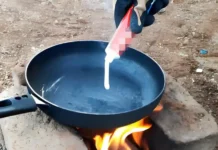Smoke inhalation is a leading cause of death in fire incidents. With recent fire incidents on the rise, it is crucial for everyone to possess essential first aid skills. In this article, we will explore how to rescue individuals suffocated by smoke in a fire and important considerations when providing immediate first aid.
Note: This article is for reference only and should not be considered a substitute for medical diagnosis or treatment.
1 The dangers of smoke inhalation in a fire
Compared to other cases of gas suffocation, suffocating from smoke in a fire is significantly more hazardous. Inhaling smoke during a fire can result in various injuries, such as injuries to the respiratory tract, lung tissue damage from heat and smoke, and exposure to other substances. These injuries can lead to systemic poisoning and even premature death.
The primary cause of premature death during a fire is typically the low oxygen concentration in the air, combined with the inhalation of carbon monoxide (CN) gas at high concentrations. This leads to oxygen deprivation, respiratory impairment, and ultimately, death. Additionally, the entry of carbon monoxide into the body alters the color of red blood cells from red to purple, impeding the delivery of oxygen and causing the individual to become unconscious.
Furthermore, fire smoke contains soot and incompletely burned organic substances. Some of these organic substances transform into compounds with toxic properties when inhaled by the body.
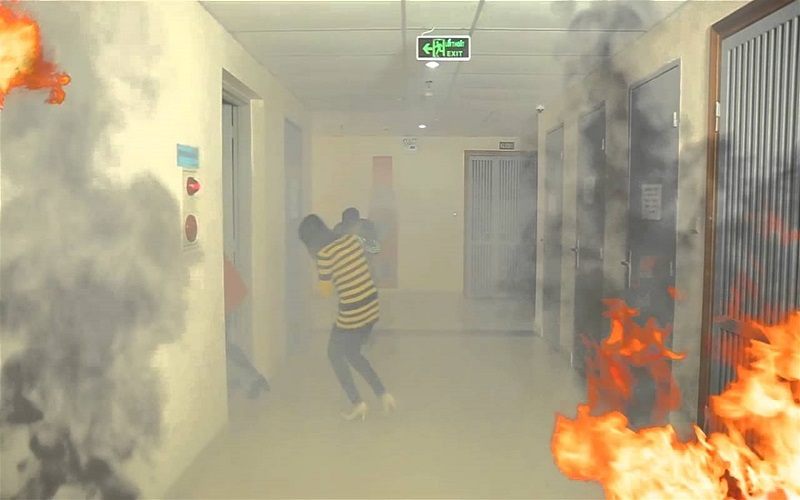
How dangerous is smoke inhalation in a fire?
2 Symptoms indicating immediate first aid for suffocated individuals
Individuals who have suffocated and require immediate first aid will exhibit the following symptoms:
- Shortness of breath: When suffocated by smoke, the respiratory tract sustains damage, reducing the oxygen supply to the blood. Chemicals present in the smoke also diminish the blood’s ability to carry oxygen, resulting in cellular oxygen deprivation. This forces the victim to breathe rapidly in an attempt to compensate for the lack of oxygen.
- Coughing: Dangerous situations trigger the production of more mucus in the respiratory tract’s mucous membranes, leading to increased mucus and bronchial spasms, resulting in coughing. The color and consistency of the mucus can vary, indicating the severity of particle burn in the victim’s lungs and airways.
- Hoarse voice: The heat and chemicals present in smoke can cause damage and constriction of the vocal cords, resulting in inflammation of the upper respiratory tract and a hoarse voice.
- Eye damage: Suffocation in a fire often leads to redness in the eyes, with potential burns occurring in the iris.
- Change in skin color: Oxygen deficiency, carbon monoxide poisoning, or exposure to fire can cause the skin to appear bluish or pale.
- Carbon deposits: Carbon deposits manifest as black patches on the body. The presence of a significant amount of carbon deposits in the nose or throat indicates a substantial intake of smoke.
- Impaired consciousness, headache: Inhaling toxic gases in smoke can result in symptoms such as rapid breathing, rapid heartbeat, drowsiness, nausea, or headaches at low concentrations. Higher concentrations can lead to arrhythmia, seizures, and even loss of consciousness.
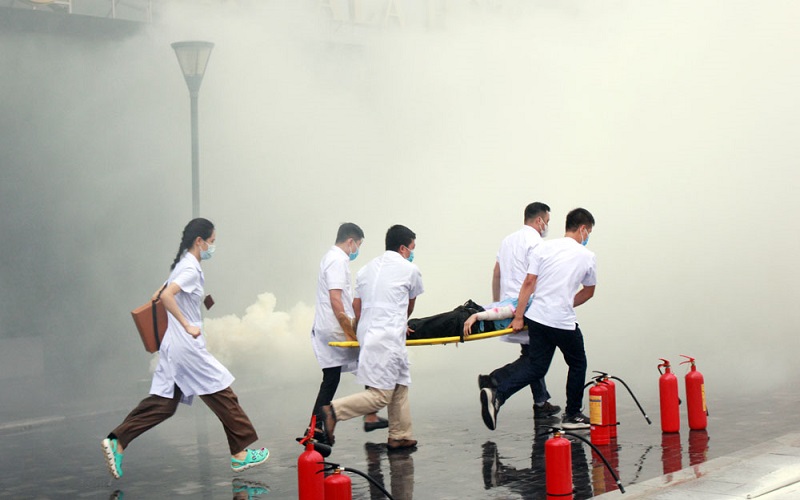
Signs that a person suffocated needs immediate first aid
3 Rescue techniques for suffocated individuals in a fire
Appropriate first aid and treatment should be administered based on the specific injuries suffered by each victim. In situations where the victim has stopped breathing, immediate cardiopulmonary resuscitation (CPR) should be performed, followed by transporting the victim to the nearest medical facility for timely treatment. Below are specific first aid methods for various cases:
- For conscious and breathing victims: Place the victim in a well-ventilated, shaded area and provide them with water to reduce body temperature and replenish lost fluids.
- For unconscious but still breathing victims: Position the victim in a tilted position to prevent airway blockage caused by phlegm. If an oxygen cylinder is available, administer oxygen immediately.
- For unconscious, irregular breathing, or non-breathing victims: Perform CPR promptly by applying chest compressions and mouth-to-mouth resuscitation. Start by placing the victim on a hard surface, interlace your hands together, position the palm of your hand in the center of the victim’s chest, and apply quick and forceful compressions. After approximately 30 compressions, administer two breaths. Repeat this process until the victim regains consciousness or medical professionals arrive. When giving breaths, seal the victim’s nose securely with both hands to prevent air from escaping.
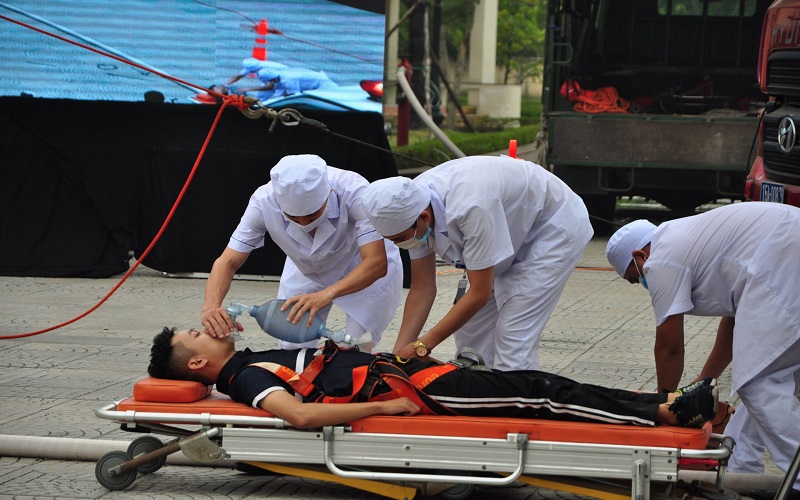
For unconscious, irregular breathing, or non-breathing victims
First aid for burn victims:
When a person suffers burns, gently pour water over their body to alleviate pain. Avoid using excessively cold water or applying ice packs directly to the burned area to prevent frostbite.
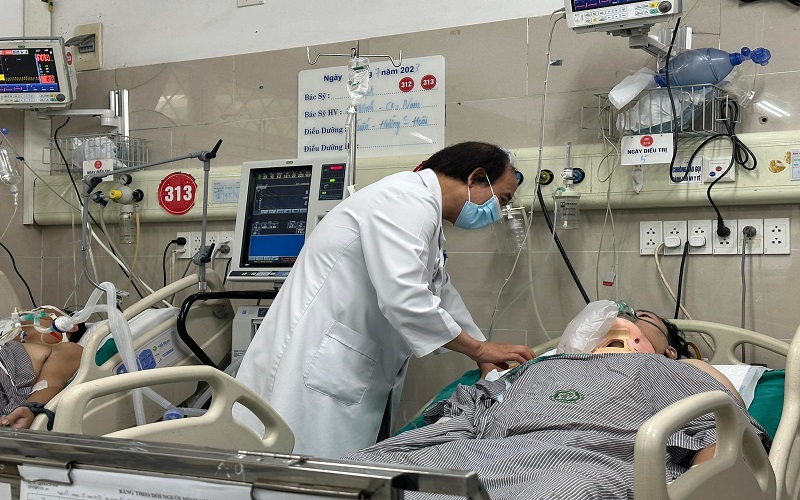
How to rescue a suffocated person in a fire
4 Strategies to prevent inhaling toxic gases in a fire
To minimize the inhalation of toxic gases during a fire, consider the following methods:
- When a fire occurs, promptly contact the fire rescue team and quickly proceed to the rooftop or balcony to signal for help.
- When faced with a fire, use a damp blanket or thick cloth to cover your nose. The water in the fabric will help filter out toxic gases and prevent their inhalation.
- Lie down on the floor, bend your arms and knees, and crawl towards an exit. Smoke tends to rise, and the floor will have a higher oxygen supply at that level.
- If trapped in a room, close the door to restrict smoke entry. Seal any openings and ventilation fans using a wet cloth or duct tape.
- In case of clothing catching fire, roll the person back and forth until the flames are extinguished.
- Remain calm, determine the direction of the wind and the source of the smoke, then select a suitable exit.
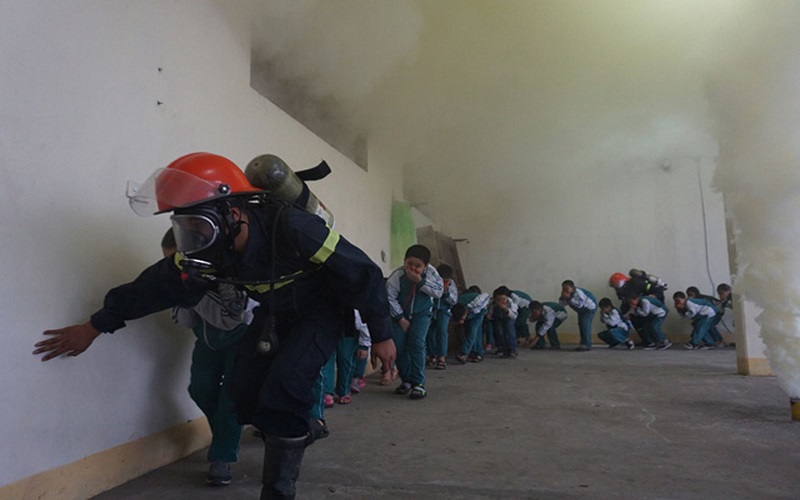
How to prevent inhaling toxic gases
Through the information presented in this article, we have gained knowledge on rescuing individuals suffocated by smoke in a fire and important first aid considerations. We hope that these insights can serve as a useful reference for encountering victims of suffocation or fire incidents.
Source: Tâm Anh General Hospital
Tips for Parents on Dealing with Common Ailments in Young Children
Winter can be a particularly hard time for little ones when it comes to keeping healthy. With the decrease in temperature and shorter days, minor illnesses that often affect children can start to present themselves. To ensure your child remains in good health and to learn how to tackle minor ailments efficiently, here are 10 tips for parents to take into consideration.






























